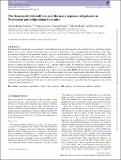Files in this item
The Kennicutt-Schmidt law and the main sequence of galaxies in Newtonian and Milgromian dynamics
Item metadata
| dc.contributor.author | Zonoozi, Akram Hasani | |
| dc.contributor.author | Lieberz, Patrick | |
| dc.contributor.author | Banik, Indranil | |
| dc.contributor.author | Haghi, Hosein | |
| dc.contributor.author | Kroupa, Pavel | |
| dc.date.accessioned | 2022-01-17T15:30:16Z | |
| dc.date.available | 2022-01-17T15:30:16Z | |
| dc.date.issued | 2021-10 | |
| dc.identifier | 277462061 | |
| dc.identifier | de949d07-cd78-4f13-9821-bbed6471a2d7 | |
| dc.identifier | 85114454708 | |
| dc.identifier.citation | Zonoozi , A H , Lieberz , P , Banik , I , Haghi , H & Kroupa , P 2021 , ' The Kennicutt-Schmidt law and the main sequence of galaxies in Newtonian and Milgromian dynamics ' , Monthly Notices of the Royal Astronomical Society , vol. 506 , no. 4 , pp. 5468-5478 . https://doi.org/10.1093/mnras/stab2068 | en |
| dc.identifier.issn | 0035-8711 | |
| dc.identifier.other | ORCID: /0000-0002-4123-7325/work/106397613 | |
| dc.identifier.uri | https://hdl.handle.net/10023/24682 | |
| dc.description | Funding: Supported in part by Fondazione Cassa di Risparmio in Bologna, Project: “Biologia e clinica delle gravi insufficienze d’organo”, year 1999. | en |
| dc.description.abstract | The Kennicutt-Schmidt law is an empirical relation between the star formation rate surface density (ΣSFR) and the gas surface density (Σgas) in disc galaxies. The relation has a power-law form ΣSFR ∝ Σgasn. Assuming that star formation results from gravitational collapse of the interstellar medium, ΣSFR can be determined by dividing Σgas by the local free-fall time tff. The formulation of tff yields the relation between ΣSFR and Σgas, assuming that a constant fraction (ΣSFE) of gas is converted into stars every tff. This is done here for the first time using Milgromian dynamics (MOND). Using linear stability analysis of a uniformly rotating thin disc, it is possible to determine the size of a collapsing perturbation within it. This lets us evaluate the sizes and masses of clouds (and their tff) as a function of Σgas and the rotation curve. We analytically derive the relation ΣSFR ∝ Σgasn both in Newtonian and Milgromian dynamics, finding that n = 1.4. The difference between the two cases is a change only to the constant pre-factor, resulting in increased ΣSFR of up to 25 per cent using MOND in the central regions of dwarf galaxies. Due to the enhanced role of disc self-gravity, star formation extends out to larger galactocentric radii than in Newtonian gravity, with the clouds being larger. In MOND, a nearly exact representation of the present-day main sequence of galaxies is obtained if ϵSFE = constant ≈ 1.1 per cent. We also show that empirically found correction terms to the Kennicutt-Schmidt law are included in the here presented relations. Furthermore, we determine that if star formation is possible, then the temperature only affects ΣSFR by at most a factor of √2. | |
| dc.format.extent | 11 | |
| dc.format.extent | 3868645 | |
| dc.language.iso | eng | |
| dc.relation.ispartof | Monthly Notices of the Royal Astronomical Society | en |
| dc.subject | Galaxies: ISM | en |
| dc.subject | Galaxies: Star formation | en |
| dc.subject | Galaxies: Statistics | en |
| dc.subject | Galaxy: Disc | en |
| dc.subject | Gravitation | en |
| dc.subject | Instabilities | en |
| dc.subject | QB Astronomy | en |
| dc.subject | QC Physics | en |
| dc.subject | Space and Planetary Science | en |
| dc.subject | Astronomy and Astrophysics | en |
| dc.subject | T-DAS | en |
| dc.subject.lcc | QB | en |
| dc.subject.lcc | QC | en |
| dc.title | The Kennicutt-Schmidt law and the main sequence of galaxies in Newtonian and Milgromian dynamics | en |
| dc.type | Journal article | en |
| dc.contributor.institution | University of St Andrews. School of Physics and Astronomy | en |
| dc.identifier.doi | https://doi.org/10.1093/mnras/stab2068 | |
| dc.description.status | Peer reviewed | en |
| dc.identifier.url | https://arxiv.org/abs/2109.00497 | en |
This item appears in the following Collection(s)
Items in the St Andrews Research Repository are protected by copyright, with all rights reserved, unless otherwise indicated.

